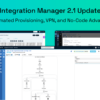If you’ve had any interaction with EDI transactions in your company, it’s likely that you’ve heard someone talk about the EDI X12 standard. If this standard is new to you, you may be curious about what it is, where it came from, and how it’s used today.
EDI X12
X12 is a message formatting standard used with Electronic Data Interchange (EDI) documents for trading partners to share electronic business documents in an agreed-upon and standard format. It is the most common EDI standard used in the United States.
Companies use EDI X12 to share documents such as invoices, catalogs, claims, purchase orders, and more. The X12 standard is important in a number of industries, including manufacturing, insurance, supply chain, finance, and transportation. There is also a subset of standards that address challenges in industries like automotive, petroleum, chemical, and healthcare, most notably the HIPAA X12 subset for health insurance.
The Development and Evolution of X12
The X12 standard was created by the Accredited Standards Committee (ASC) at the direction of the American National Standards Institute (ANSI). ASC X12 was so named because of the way ANSI assigned standard designations at the time it was developed.
The ASC continues to oversee the standard today, including versioning and structure of the standard. Each X12 document has a 3-number identification that indicates the kind of information it holds. For instance, an X12 850 document is a purchase order, an X12 810 document is an invoice, and an X12 837 is a health care claim.
All ASC X12 documents share the same basic structure or segments. Not all segments are required for a valid message.
- ISA – the interchange header; hold information about the recipient and the sender
- GS – A header indicating the functional group for an X12 transaction set
- ST – the transaction set header, marketing the start of the transaction set
- SE – the transaction set trailer, marking the end of the transaction set
- GE – the functional group trailer, indicating the end of a group of transaction sets
- IEA – the end of the interchange, with data specific to the functional group and reference number
Challenges of EDI ASC X12
While X12 is a standard, there are enough subsets and variations that automating processing and routing of documents can be challenging for businesses initially on-boarding a trading partner relationship, or a partner changes something in their format.
EDI X12 can present multiple challenges for small to medium-sized businesses. One of the biggest challenges is onboarding – configuring and customizing message processing for new trading partners or updating configurations for established ones. Once configured, the complication switches to monitoring for errors and troubleshooting problems that arise.
Traditionally, solutions that help to automate EDI X12 processing have been expensive and out of the reach of small-to-midsized enterprises – namely the ones who would benefit the most from having an error-free automated process in place for handling invoices, claims, and so forth.
Additionally, the skill set for programming and managing X12 documents is becoming scarce. Since EDI is an older technology, EDI analysts are moving out of the workforce and new software engineers have little interest in learning a more than 40-year-old standard.
Answering X12 Challenges with APIs
The challenges that EDI X12 faces are the kinds of problems that APIs are used to help solve. Reusability, open interfaces, and modern architecture principles alleviate the complications of one-off configurations and onboarding complications. Interfaces built to monitor message flow can be re-used and modified for alerting and performance monitoring.
Leveraging APIs for X12 management has the added bonus of opening up the resource pool required. Integration developers can be involved, and with the right tools, business analysts can manage parts of the process as well. The issues of a dwindling pool of expertise becomes less of a problem.
If you’re looking for an effective, intuitive, and cost-conscious solution to processing X12 messages, while also moving towards more modern APIs, let us know. PortX now offers a user-friendly translator as part of the Partner Manager platform that simplifies the automation of X12 messages.






